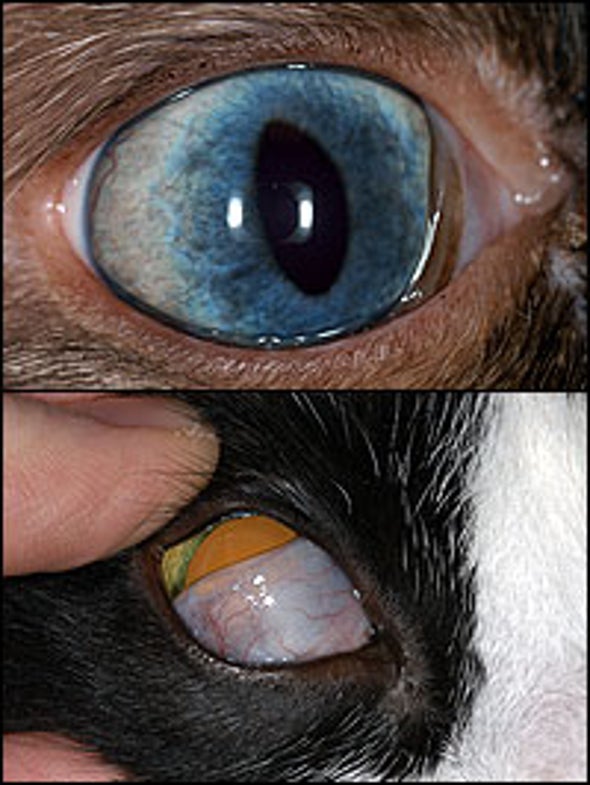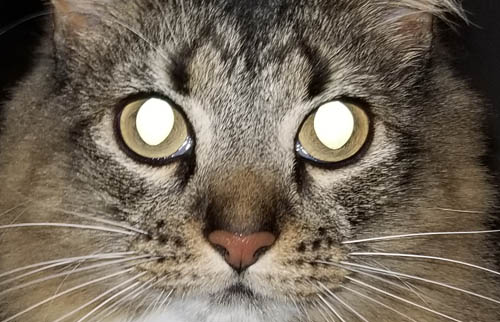
Cats cant move their jaws side to side but they can open it like humans do to eat food. Abnormal eye position referred to as strabismus.

Cross-eyed cats are just like any other cats.
Do cats eyes move side to side. Cats cannot move their eyes as a whole. Therefore they have to move their heads just like humans to locate anything on the sides. However they can change them to adapt to different conditions and communicate different emotions.
As mentioned earlier they can roll their eyes move their eyelids blink close their eyes squint dilate their pupils and constrict them. Cats cant move their jaws side to side but they can open it like humans do to eat food. What do your eyes do when you are sleeping.
Your eyes move slowly side to side under. Can cats move their eyes. Yes just like humans cats can move their eyes from side to side and up and down.
This range of motion is limited. How are cat eyes different from human eyes. The eyes of the cat differ from human eyes in several ways.
The light-sensitive tissue at the back of the eye contains rods and cones which respond to light and colour. Involuntary eye movement in cats is often part of feline vestibular syndrome. This uncommon disorder of the nervous system will cause your cat to become less coordinated than usual and may result in your cat falling to one side walking unsteadily or struggling to balance normally.
Using the up and down movement of their lids along with the side-to-side movement of their pupils cats can fine tune their vision with pinpoint accuracy. See in darkness Cats as well as dogs have a layer of cells at the back of their eyes that is. Does the Siamese cat move their eyes side to side.
Yes of course we all know that cats just like humans have unlimited peripheral vision ie they can only roll their eyes to view anything located sideways. So its normal to see your Siamese cats eyes moving from side to side when looking for an object placed on either side. Cats can move their eyes but only in a limited way.
They have a wide field of vision unlike a humans but poor peripheral vision so they move their heads to see a full view. My cat is moving his head back and forth and his eyes are moving side to side. His whole body feels weak and he cant stand.
Its been very cold in the house lately. Vestibular disease in cats is a condition in which a cat suddenly develops incoordination falling or circling to one side involuntary darting of the eyes back and forth nystagmus a head tilt and often nausea or vomiting. These clinical signs usually appear suddenly many times in less than an hour.
Many conditions can cause the disease and. Tilted head in your cat. Repeatedly falling or leaning to one side.
Abnormal eye movement referred to as nystagmus. Abnormal eye position referred to as strabismus. Walking around in circles less common nausea and diarrhea independently or together especially after a seizure less common.
The nystagmus or rotary movement of the eyes are a normal finding in some breeds of cats. These are usually very mild like what we saw with Trigg. Increased nystagmus can cause balance problems and that is when we need to treat.
If Trigg is having trouble with balance or has a permanent tilt to his head then we should take a look. Small muscles control eye movement up and down and side to side. When an eye muscle is too short or too long or if the nerves or part of the brain that controls the eye muscles are damaged then the eyes move in abnormal directions causing a cat to look cross-eyed.
Nystagmus involves a cats eyes moving from side to side rapidly. According to AnimalPath there are two types of nystagmus jerk nystagmus and pendular nystagmus. In jerk nystagmus the eye moves slowly from one side to the other in one direction and rapidly from side to side in the other direction.
Examine the cats eyes. Look closely at your cats eyes. If he has had a stroke his pupils may be different-sized or his eyes may flick from side to side.
This is called nystagmus and it is due to a lack of blood supply to the nerves that feed the eyes. You may notice your cats eyes moving erratically from one side to another as it struggles to keep its balance. Head tilt is usually one of the first obvious signs of vestibular syndrome.
Vet bills can sneak up on you. What are the signs of vestibular syndrome in dogs and cats. Common signs of vestibular syndrome in dogs and cats include falling head tilt rotation of the head with one ear held lower than the other flickering of the eyeball from side-to-side or up and down nystagmus general wobbliness often with the animal drifting to one side as he moves around andor circling.
As a result of the vestibular disturbance cats may also exhibit rapid abnormal eye movements or tilt their head side to side. Vestibular disease can stem from a number of different causes such as a serious ear infection encephalitis meningitis meningoencephalitis or. Wide open eyes means your cat is ultra-alert and ready for anything.
If your cat has one ear pointed forward while the other is back he may be unsure of something. If his eyes are dilated he is interested or wary of something and may be preparing to attack or flee. They position the eyeball to slide from top to bottom or side to side.
However in certain cases one muscle may be longer or stronger than the one on the opposite side of the eye this causes the eyeball to deviate off the correct direction. If the eyes deviate towards the nose the cat is cross-eyed. Cross-eyed cats are just like any other cats.
Some members of the oriental breeds have a congenital problem with nystagmus which is rapid movement of the eye usually side to side can be up and down or rotational though. This is most common in Siamese cats but I have seen it in other oriental breeds on a. Head tilt is a medical condition that may be indicative of a serious underlying disorder usually of the vestibular system.
If a cat is tilting its head frequently to either side of the body away from its orientation with the trunk and limbs this. Why does my cats eyes Exotic move rapidly back and forth. - Answered by a verified Cat Vet.
My cat tilts his head to one side walk in circles before walking or lying down and drags one of his back legs. His balance is off. I took him to the vet and they could not find anything wrong.